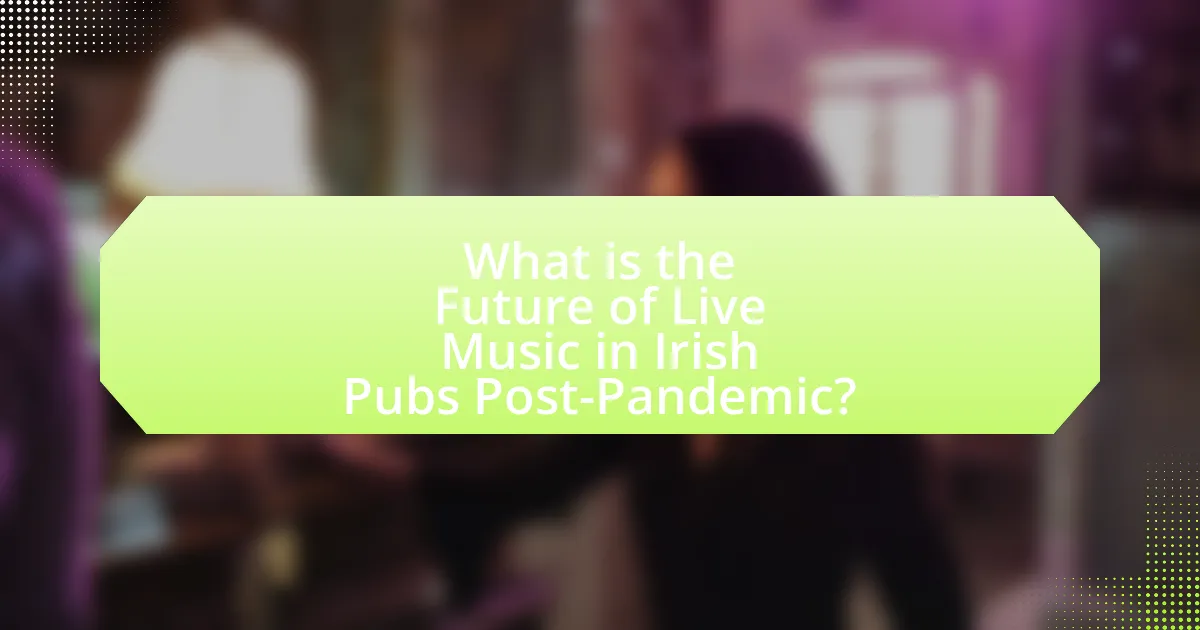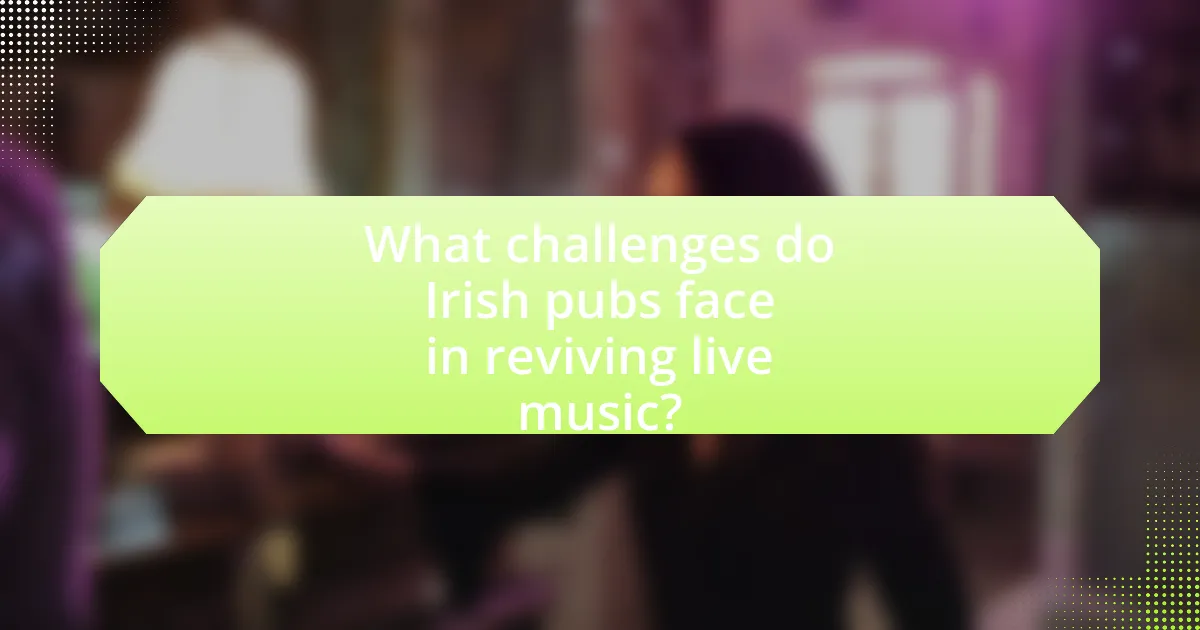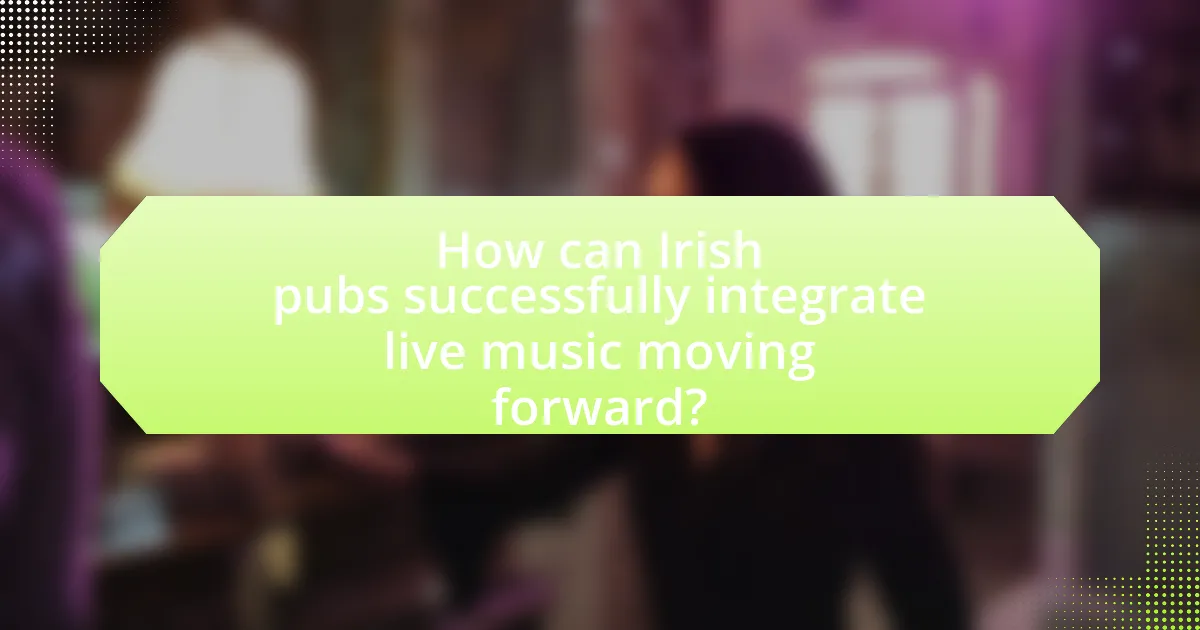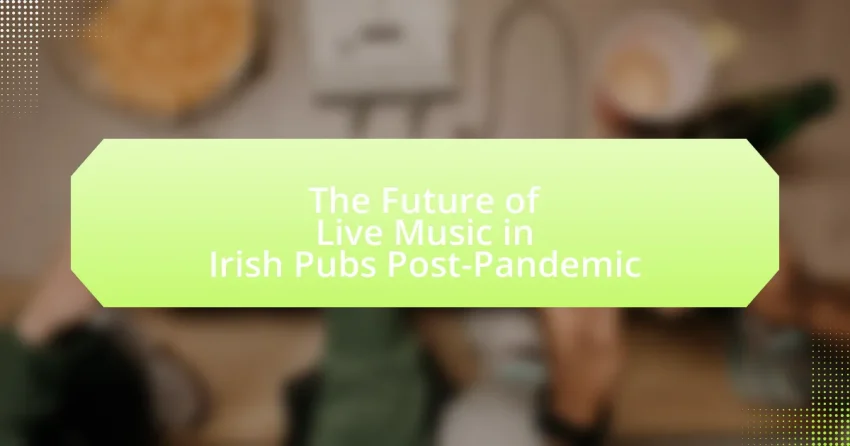The article examines the future of live music in Irish pubs following the pandemic, highlighting the anticipated resurgence of performances as venues adapt to new health guidelines and consumer preferences. It discusses the significant impact of the pandemic on live music attendance, the financial challenges faced by pubs, and the emerging trends such as outdoor performances and a focus on local artists. Additionally, the article outlines strategies for pubs to successfully integrate live music, including the use of technology, targeted marketing, and partnerships with local musicians, while addressing the importance of safety measures and audience engagement in revitalizing the live music scene.

What is the Future of Live Music in Irish Pubs Post-Pandemic?
The future of live music in Irish pubs post-pandemic is expected to see a resurgence as venues adapt to new health guidelines and consumer preferences. Many pubs are likely to implement outdoor performances and smaller, more intimate shows to accommodate social distancing, which aligns with the growing trend of outdoor dining and entertainment. Additionally, the demand for live music remains strong, as evidenced by a survey conducted by the Irish Music Industry, which indicated that 70% of respondents are eager to return to live music events. This indicates a robust market for live performances, suggesting that Irish pubs will continue to be vital cultural hubs for music and community engagement.
How has the pandemic affected live music in Irish pubs?
The pandemic has significantly disrupted live music in Irish pubs by enforcing prolonged closures and capacity restrictions. During the height of the COVID-19 crisis, many pubs were forced to shut down entirely, leading to a loss of income for musicians and venues alike. According to a report by the Irish Music Industry Collaborative, over 80% of musicians experienced a substantial decline in income due to the cancellation of gigs and events. As restrictions eased, social distancing measures limited audience sizes, further impacting the viability of live performances. This situation has led to a shift in how live music is presented, with many venues adopting outdoor performances and virtual events to adapt to new health guidelines.
What changes occurred in live music attendance during the pandemic?
Live music attendance significantly declined during the pandemic due to health restrictions and social distancing measures. According to a report by the National Independent Venue Association, 90% of independent venues in the U.S. reported a complete shutdown during the pandemic, leading to a drastic reduction in live music events. Additionally, a survey by Pollstar indicated that global concert attendance dropped by 75% in 2020 compared to previous years, highlighting the widespread impact on live music participation.
How did pub owners adapt to restrictions on live music?
Pub owners adapted to restrictions on live music by diversifying entertainment options and enhancing outdoor spaces. Many pubs introduced alternative forms of entertainment, such as quiz nights, DJ sets, and virtual performances, to maintain customer engagement. Additionally, they invested in outdoor seating and infrastructure to accommodate social distancing, allowing for live music events in open-air settings when regulations permitted. This shift not only complied with health guidelines but also attracted patrons seeking safe social experiences, demonstrating resilience in the face of challenges posed by the pandemic.
What are the emerging trends in live music for Irish pubs?
Emerging trends in live music for Irish pubs include the integration of technology, such as live streaming performances, and a focus on local artists to enhance community engagement. The COVID-19 pandemic has accelerated the adoption of digital platforms, allowing pubs to reach wider audiences through virtual events. Additionally, there is a growing preference for intimate acoustic sessions, which cater to smaller crowds and create a more personal atmosphere. According to a survey by the Irish Music Rights Organisation, 70% of pub owners reported an increase in demand for local acts, reflecting a shift towards supporting homegrown talent.
How are technology and streaming influencing live music performances?
Technology and streaming are significantly enhancing live music performances by expanding audience reach and improving production quality. Streaming platforms allow artists to broadcast their performances to global audiences, breaking geographical barriers and increasing potential revenue. For instance, during the pandemic, many musicians turned to platforms like Twitch and YouTube to perform live, resulting in millions of viewers and new fan engagement opportunities. Additionally, advancements in sound and video technology enable higher-quality audio and visual experiences, making live performances more immersive. According to a report by the International Music Summit, the global live music market is projected to grow, partly due to these technological innovations, indicating a lasting impact on how live music is experienced.
What role do local artists play in the future of live music in pubs?
Local artists are essential to the future of live music in pubs, as they provide unique, authentic performances that attract patrons and foster community engagement. Their presence helps pubs differentiate themselves in a competitive market, especially as venues seek to recover from pandemic-related closures. According to a report by the Arts Council of Ireland, local musicians contribute significantly to the cultural landscape, enhancing the social experience of pub-goers and supporting local economies. This symbiotic relationship between local artists and pubs not only revitalizes the live music scene but also strengthens community ties, making local artists pivotal for the sustainability and growth of live music in these venues.

What challenges do Irish pubs face in reviving live music?
Irish pubs face several challenges in reviving live music, primarily due to financial constraints, changing consumer preferences, and regulatory restrictions. Financially, many pubs experienced significant revenue losses during the pandemic, leading to reduced budgets for hosting live music events. Additionally, consumer preferences have shifted, with some patrons favoring quieter environments or alternative entertainment options, which diminishes the demand for live performances. Regulatory restrictions, including capacity limits and health guidelines, further complicate the ability of pubs to host live music events effectively. These factors collectively hinder the revival of live music in Irish pubs.
How are health and safety regulations impacting live music events?
Health and safety regulations significantly impact live music events by enforcing strict guidelines that ensure the safety of attendees and performers. These regulations often require venues to implement measures such as capacity limits, social distancing, and enhanced sanitation protocols, which can reduce audience size and alter the overall experience. For instance, the COVID-19 pandemic led to the introduction of specific health guidelines that mandated mask-wearing and vaccination proof for entry, directly affecting attendance and ticket sales. Additionally, compliance with these regulations can increase operational costs for venues, as they may need to invest in safety equipment and staff training.
What measures are being implemented to ensure safety during performances?
To ensure safety during performances in Irish pubs post-pandemic, venues are implementing measures such as enhanced sanitation protocols, social distancing guidelines, and capacity limits. Enhanced sanitation includes regular cleaning of high-touch surfaces and providing hand sanitizers for patrons. Social distancing guidelines require maintaining a safe distance between audience members, often leading to reduced seating arrangements. Capacity limits are enforced to prevent overcrowding, ensuring that venues do not exceed recommended occupancy levels. These measures are supported by public health guidelines aimed at minimizing the risk of COVID-19 transmission during live events.
How do these regulations affect audience turnout?
Regulations significantly impact audience turnout in Irish pubs post-pandemic by imposing capacity limits and health protocols. These restrictions can lead to reduced attendance as potential patrons may feel discouraged by the limitations on the number of people allowed in venues, which can create a less vibrant atmosphere. For instance, studies have shown that venues operating at reduced capacity often experience a decline in audience numbers, as seen in various sectors during the pandemic, where compliance with health guidelines resulted in a 30-50% drop in attendance rates. Additionally, the requirement for social distancing and mask-wearing can deter individuals from attending live music events, further affecting turnout.
What financial challenges do pubs encounter in hosting live music?
Pubs encounter several financial challenges when hosting live music, including high costs for artist fees, equipment, and licensing. The expense of hiring musicians can significantly impact a pub’s budget, as professional acts often demand substantial payment. Additionally, pubs must invest in sound equipment and venue modifications to accommodate live performances, which can further strain financial resources. Licensing fees for public performance rights, which are required to legally host live music, add another layer of financial burden. According to a report by the Music Venue Trust, many small venues struggle to cover these costs, leading to a reliance on ticket sales and drink revenue that may not always meet expectations.
How has the cost of hosting live music changed post-pandemic?
The cost of hosting live music has increased post-pandemic due to higher operational expenses and changes in demand. Venues now face increased costs for health and safety measures, such as enhanced sanitation and crowd control, which have raised overall expenses by approximately 20-30%. Additionally, many artists have adjusted their fees to reflect the increased cost of living and the reduced number of gigs available, further driving up the cost for venues. According to a survey by the Music Venue Trust, 70% of venues reported that booking fees for artists have risen since the pandemic, indicating a significant shift in the financial landscape for live music events.
What funding or support options are available for pubs?
Pubs can access various funding and support options, including government grants, local authority funding, and industry-specific initiatives. For instance, the Irish government has implemented the “Restart Grant Scheme,” which provides financial assistance to businesses, including pubs, to help them recover from the pandemic’s impact. Additionally, the “Live Performance Support Scheme” offers funding specifically for live music events in pubs, aiming to revitalize the live music scene. Furthermore, organizations like the Vintners’ Federation of Ireland advocate for pub owners and provide resources for financial support. These funding avenues are crucial for sustaining operations and promoting live music in Irish pubs post-pandemic.

How can Irish pubs successfully integrate live music moving forward?
Irish pubs can successfully integrate live music moving forward by adopting a hybrid model that combines in-person performances with digital streaming options. This approach allows pubs to reach a wider audience, including those who may not be able to attend physically due to health concerns or geographical limitations. For instance, a study by the Irish Music Rights Organisation indicates that live-streamed events can increase audience engagement and revenue by up to 30%. Additionally, creating partnerships with local musicians and offering them fair compensation can enhance the quality and variety of performances, attracting more patrons. Implementing safety measures, such as social distancing and improved ventilation, will also reassure customers and encourage attendance at live events.
What strategies can pubs use to attract audiences to live music events?
Pubs can attract audiences to live music events by implementing targeted marketing strategies, enhancing the overall experience, and collaborating with local artists. Targeted marketing strategies include utilizing social media platforms to promote events, creating engaging content that highlights the performers, and offering special promotions or discounts for attendees. Enhancing the overall experience involves improving the venue’s ambiance, providing quality sound systems, and ensuring a diverse drink and food menu that complements the music. Collaborating with local artists not only supports the community but also draws in their fan base, increasing attendance. According to a study by the Music Venue Trust, venues that actively engage with their local music scene see a 30% increase in audience turnout for events.
How can marketing and promotion enhance live music attendance?
Marketing and promotion can significantly enhance live music attendance by effectively reaching target audiences and creating awareness about events. Strategic marketing campaigns, including social media advertising, email newsletters, and local partnerships, can generate buzz and attract potential attendees. For instance, a study by Eventbrite found that 80% of event attendees discover events through social media, highlighting its importance in driving attendance. Additionally, promotional tactics such as early bird ticket sales and exclusive offers can incentivize purchases, leading to increased turnout. By leveraging these marketing strategies, venues can create a compelling narrative around live music events, ultimately boosting attendance in the post-pandemic landscape.
What partnerships can pubs form to support live music initiatives?
Pubs can form partnerships with local musicians, music schools, and community organizations to support live music initiatives. Collaborating with local musicians allows pubs to host regular performances, enhancing their entertainment offerings while providing artists with a platform to showcase their talent. Partnering with music schools can facilitate events such as student showcases or workshops, fostering community engagement and attracting diverse audiences. Additionally, collaborating with community organizations can help pubs organize music festivals or themed nights, further promoting local culture and increasing foot traffic. These partnerships not only enrich the live music scene but also contribute to the economic vitality of the pub and the surrounding community.
What best practices should pubs follow for hosting live music?
Pubs should prioritize sound quality, audience engagement, and safety when hosting live music. Ensuring high-quality sound equipment and acoustics enhances the listening experience, which is crucial for attracting patrons. Engaging the audience through interactive performances or themed nights fosters a vibrant atmosphere, encouraging repeat visits. Additionally, implementing safety measures, such as crowd control and health protocols, is essential in the post-pandemic landscape to protect both performers and attendees. These practices not only improve the overall experience but also contribute to the pub’s reputation and financial success in a competitive market.
How can pubs create an engaging atmosphere for live music?
Pubs can create an engaging atmosphere for live music by optimizing their space for sound quality and audience interaction. This involves using acoustic treatments to enhance sound clarity and strategically arranging seating to encourage participation and visibility. Research indicates that venues with good acoustics and thoughtful layouts can increase audience enjoyment and engagement, leading to higher attendance rates. Additionally, incorporating elements such as themed nights, local artist showcases, and interactive performances can foster a sense of community and excitement, which is crucial for revitalizing the live music scene in Irish pubs post-pandemic.
What are the key considerations for scheduling live music events?
Key considerations for scheduling live music events include venue capacity, audience demographics, and timing. Venue capacity determines how many attendees can be accommodated, impacting ticket sales and safety regulations. Audience demographics influence the choice of music genre and artist, ensuring the event appeals to the target audience. Timing is crucial, as scheduling events on weekends or during holidays typically attracts larger crowds. Additionally, considering local regulations and potential noise complaints is essential for compliance and community relations. These factors collectively enhance the likelihood of a successful live music event.
What tips can pubs implement to ensure the success of live music?
Pubs can ensure the success of live music by curating a diverse lineup of local talent that resonates with their target audience. This approach not only fosters community engagement but also attracts patrons who appreciate supporting local artists. Research indicates that venues featuring local musicians can see a 20% increase in foot traffic, as these events create a unique atmosphere that encourages repeat visits. Additionally, promoting events through social media and local advertising can enhance visibility and draw larger crowds, further validating the importance of strategic marketing in the success of live music initiatives.
